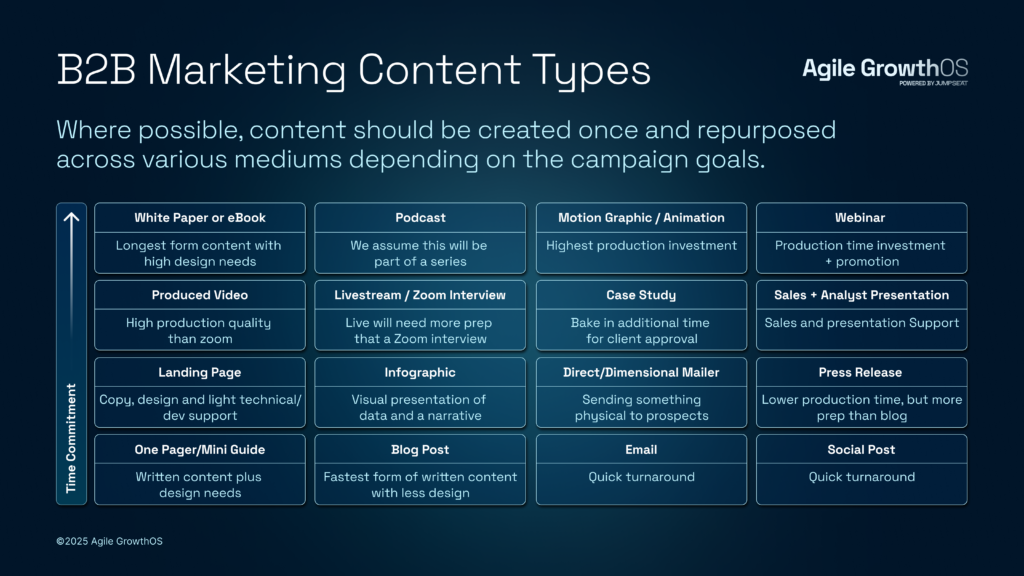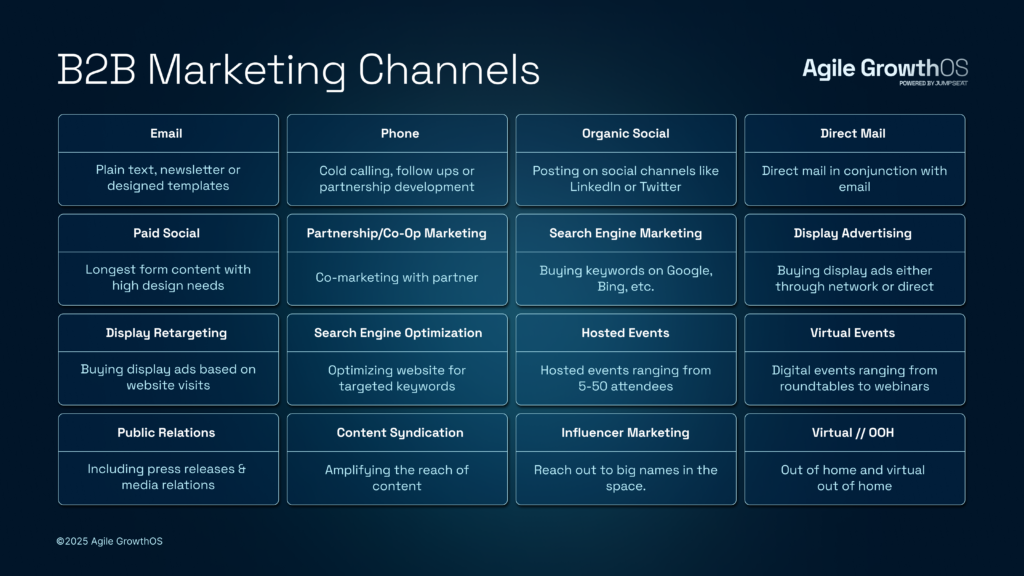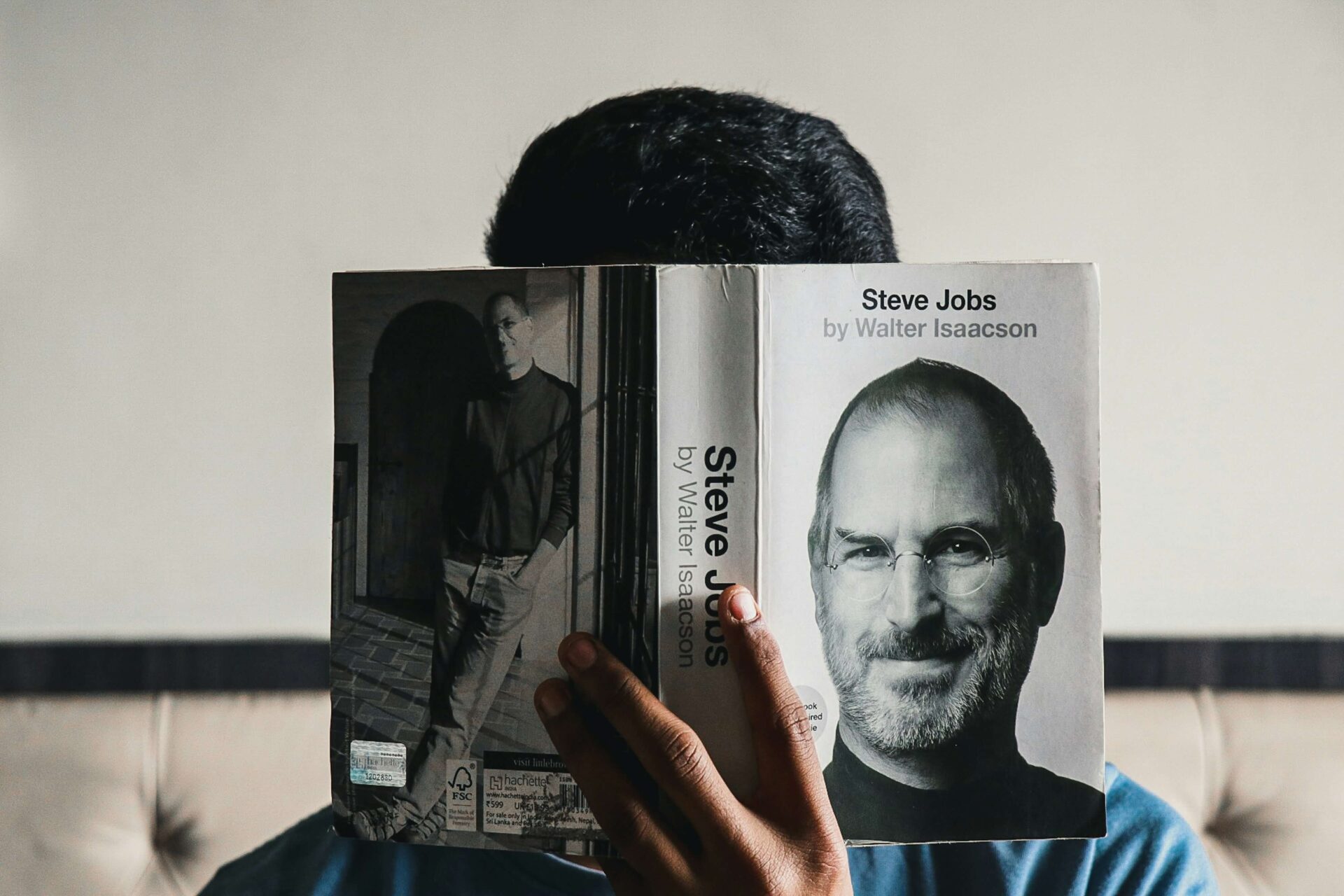In September 1997, Apple was on the brink of bankruptcy.
Twelve years after Steve Jobs left the company he co-founded, Apple reported a quarterly loss of $161 million and accumulated over $1.5 billion in losses over two years. The company was just 90 days away from running out of cash and shutting down.
We all know how the story ends. Today, Apple is the most valuable company in the world, worth over $2 trillion.
Although Jobs is known for his insights on many topics, one core belief played a crucial role in Apple’s historic turnaround:
“Do not try to do everything. Do one thing well"
In his first six months back at Apple, Jobs cut the product line by 97%—from 350 products to just 10. Over the next 20 years, six products drove Apple’s success: the iMac, MacBook, iPod, iPhone, iPad, and Apple Watch.
This principle applies to many areas of business, particularly in B2B marketing, where brands compete for attention across countless channels.
As of 2025, the average North American sees anywhere from 5,000 to 30,000 brand messages per day.
So, how will you stand out? A good starting point is choosing the right channel and committing to it.
Own the Channel: Shining Examples
Let’s begin by examining those who have done a killer job of “owning the channel” in their own right. These companies and individuals didn’t just dip a toe into content—they went all in, making it the foundation of their success.
Morning Brew grew its newsletter from a dorm-room project to a $75 million media company with 2.5 million subscribers in fewer than six years. They didn’t dabble in a newsletter once a month—they built an entire company around it, obsessively perfecting their approach to engaging business news for a younger audience.
HubSpot didn’t just start a blog; they pioneered an entire movement. They grew from zero to over $100 million in eight years, coined the term “inbound marketing.” and ranked #5 worldwide in search traffic for online marketing tech. Their playbook? Blogging + SEO, all day, every day.
Sangram Vajre, one of the founders of Terminus, didn’t just start a podcast—he committed to it daily for three years, producing over 1,000 episodes of FlipMyFunnel. His approach wasn’t about testing the waters; it was about full-scale momentum. That relentless cadence helped define and popularize the account-based marketing (ABM) movement, positioning Terminus as the category leader and making FlipMyFunnel a Top 50 Business Podcast.
Seth Godin has been the #1 marketing blogger in the world for decades. In addition to being an entrepreneur, a speaker, and the author of more than 20 books, he has written a blog every single day—proving that consistency breeds authority.
Clutch.co didn’t just build a directory; they built the directory for B2B services. Search for almost any type of B2B firm and a city (e.g., top IT consulting firms in Chicago), and presto—Clutch is on the first page of Google.
The GDS Group is known for hosting high-end, three-day events for C-level executives. When the pandemic hit, few industries were hit harder than live events. But instead of sitting back, GDS pivoted fast—launching intimate virtual roundtables. Within months, they hosted more than 40 sponsored events per week, making them one of the only event firms hiring again by fall 2020 while competitors struggled.
The Common Thread? Relentless Ownership.
These aren’t stories of companies and individuals who “tried something” or posted sporadically. They owned their channels, went all in, and made their platforms their identity. That level of commitment is what separates the dabblers from the category creators.
How Will Your Channel Grow?
So, what kind of growth can you expect as you plan a channel marketing strategy? Your Channel Will Grow in One of Three Ways. Let’s review them.
1. Stone Skipping Growth:
This is how the vast majority of channels in the B2B world perform. You choose a channel, put some hypotheses around your testing strategy, and see what sticks. In reality, the channel never really takes off because you revisit the channel only every few weeks or months.
2. Linear Growth:
Little by little, attendance or engagement grows year after year. This is what you often see with events or online communities. After a few years, you have something that really takes off.
3. Exponential Growth:
Linear growth is good—don’t get us wrong—but exponential growth is the goal. This is compound marketing at work. This is where you may start off more slowly as you build, but you eventually hit an inflection point where things begin to take off.
People start incorporating you into their habits and routines. The output improves, and the channel or medium builds on itself. With linear growth, you have to keep driving things forward; with exponential growth, you usually have to continue driving it forward, but it begins to take on a life of its own.
Why Long Term-Focus Matters
1. We’re creatures of habit. We develop routines; we strive for a degree of rhythm and consistency in our lives. We often take the same commute, eat at the same restaurants, attend many of the same bars for happy hours, and, yes, read the same blog, listen to the same podcasts, and follow the same people. When you create high-quality content and show up every day, you become part of people’s routines, and when that happens, you can create a small but loyal tribe of followers. You know you’ve succeeded when people ask for your content and notice when you’re not there.
2. Tribes become communities. Here’s the thing about strong tribes: Members wear their membership as a badge of honor, spread the word, and help turn a tribe into a community. Especially in the age of social media algorithms that strongly reward organic signals and reach, it’s not long before your tribe is helping propel you toward exponential growth.
3. Your output improves. If you’re seeking and listening to feedback and constantly improving, your product inevitably gets better and stronger. When you fall victim to stone-skipping growth, you bounce between content and tactics and never benefit from iterative improvements.
Three-Step Process to Owning Your Channel
We’ll now run through a three-step process to help you effectively implement this strategy in no time.
1. Choose your Channel
2. Build Your Process
3. Execute, Optimize and Repeat
1. Choose Your Channel
Unsurprisingly, choosing your channel or medium to go all-in on is the first step. There are a couple of critical considerations as you make this choice:
- Where does your audience spend a lot of time researching, learning, hanging out, and consuming content? You’ll want to ensure you start by fishing where the fish are.
- What do you feel like you can own? If there are already half a dozen podcasts or blogs on your exact topic, consider shifting your focus or determining how to confidently deliver a better, more relevant, or more compelling experience.
- Do not discount this—choose a medium or content type you love. Seriously, if you’re going to invest a significant amount of your time and your team’s time, then that time should be spent on a channel you want to wake up excited to work on every day. As discussed in the next section, you’ll need this innate passion to create a repeatable process.
Here’s a quick visual guide to both B2B content types and channels as a starting point.

And a thought starts for channels to consider.

Important Note: We acknowledge considerable nuance within each of these content types and channels.
Two white papers are not equal.
Two blog posts will be anything but alike.
The goal here is to get your wheels turning. We’ll happily schedule a workshop to brainstorm and explore each channel for your unique scenario.
2. Build Your Process
Once you’ve chosen your ideal channel(s), the next step is to build your process.
Remember, people are creatures of habit—and that goes for the content they consume AND for your marketing team behind these efforts. Make sure to build in ceremonies to celebrate the small wins along the way.
Ideate Around Your Big Idea and Supporting Content Pillars
Clutch.co believed it could be the go-to destination for any prospect looking for new vendors or to validate current vendors. GDS Group believed executives and companies would quickly embrace virtual roundtables instead of travel. Seth Godin believed deeply in helping others take creative leaps and impact the world around them. The Morning Brew believed there was room for a slightly irreverent newsletter that delivers timely business news.
In each example, the individual or team began with a vision and an ambitious idea to change how its readers, buyers, clients, or prospects engage with its brands and categories at large.
Besides being passionate, focusing on this vision can help you through periods of doubt and the inevitable dip.
It goes without saying, but what you’re putting out must offer significant value. Whether you’re working to build a community, shoot videos, or host events if your members, guests, listeners, or readers don’t leave the experience wanting more, you need to return to the drawing board until you reach this threshold.
Put Your Channel Team in Place
Different channels require different teams, often with specific skill sets. Depending on your team’s size, consider outsourcing some tasks, particularly those involving considerable focus or expertise.
For example, if you’ve chosen podcasts as your channel, then here’s what the team breakdown might look like:

Note: Freelancers are a highly underrated talent pool, and you should consider and tap into this group as needed. Upwork, for example, handles all the legal and billing hassles, offers an enormous talent pool, and makes communication extremely easy. Consider taking this approach to complement your team’s efforts.
3. Execute, Optimize, and Repeat
Congratulations! You’re ready to execute, optimize, and repeat. Here are tips to help you build your channel over time:
At this point, you have your channel(s) to own over a predefined period. You’ve fully committed, put your subject matter experts in place, created a clean and repeatable content creation framework, and created a postproduction framework that allows you to push out promotional material quickly.
Tie your channel back to everything else you do→ Let’s say you have a podcast or a daily newsletter—again, it probably goes without saying, but cross-promotion is your best friend. As you plan your content strategy, begin with everything already happening inside your organization. This is compound marketing at its finest.
Combine paid and organic marketing→To grow exponentially, you’ll need to fire on all cylinders, including paid and organic marketing. We often recommend starting by building your base and, as you get traction, adding paid marketing to fuel the fire.
Focus on paid marketing within your channel→The Morning Brew quickly discovered that those who were most likely to subscribe to a new newsletter were already subscribing to others. When they began focusing their paid dollars on newsletter advertising, conversion took off. If you’re doing a podcast, then consider sponsoring other podcasts. The same goes for events, blogs, and other channels.
Make your partners, prospects, and clients the star of the show→Again, you’ll want to put this channel at the heart of your efforts, including pulling in your partners, prospects, clients, and anyone else important in your world. This is a great way not only to create new content but also to help start and build strong relationships.
Bake in virality→This is a long-held secret of great product designs. Dropbox grew because when someone created a folder on their platform, there was a good chance they were sharing it with others. Look for ways to engage your audience, challenge them to act, and encourage them to share with your community and the world.
Keep it timey→Seth Godin has been blogging daily for well over a decade, and although many of his posts are timeless, just as many reference current events. Relevance is key to maintaining momentum over the long term.
Keep content fresh→It’s good to get a content type, format, or approach down and run with it, but don’t be afraid to reinvent yourself and your channel. New technologies develop. New thinking emerges. New channels rise, and older ones fall. Keep an open mind, and adopt what you see and love about the latest.
Most importantly, show up. Show up regularly. Even if you don’t feel like it some days or the quality wanes, show up—this is part of building habits.
Along the way, you’ll want to measure, tweak, and optimize.






